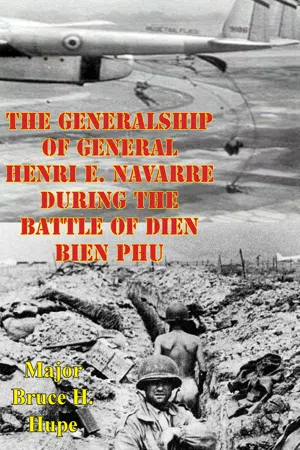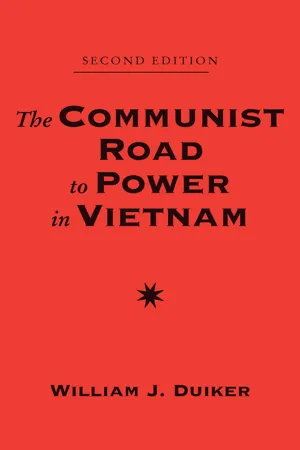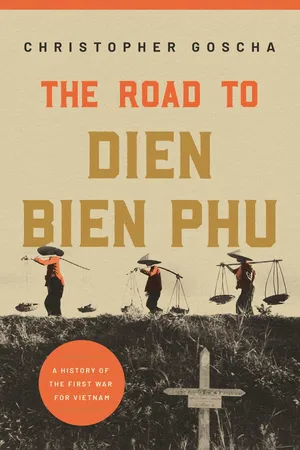Battle of Dien Bien Phu
The Battle of Dien Bien Phu was a major confrontation in the First Indochina War between the French Union forces and the Viet Minh communist revolutionaries. The battle took place in 1954 in the remote valley of Dien Bien Phu in northern Vietnam. The Viet Minh successfully besieged and defeated the French, leading to the end of French colonial rule in Indochina.
7 Key excerpts on "Battle of Dien Bien Phu"
- eBook - ePub
Vietnam
An American Ordeal
- George Donelson Moss(Author)
- 2020(Publication Date)
- Routledge(Publisher)
...News of an impending political settlement to the long war energized both sides. Generals Giap and Navarre intensified their preparations for the decisive battle of the First Indochina War. Shortly after the announcement that a peace conference would be meeting in May to settle the war, General Giap decided that the moment had come to attack Dien Bien Phu. The main objective was to inflict a decisive military defeat on the French that would coincide with the opening of the Geneva Conference in order to maximize the DRV’s leverage at the bargaining table. If the French garrison at Dien Bien Phu fell, the Vietminh would retain the military initiative. A defeat at Dien Bien Phu would probably destroy the remaining French will to continue the war. 64 In the aftermath of a decisive Vietminh victory, the Vietminh leaders believed that the war-weary French might abandon Vietnam. Giap was confident that he and his staff had devised a strategy that would bring the Vietminh forces victory at Dien Bien Phu. He planned a siege of the French positions. He also planned to destroy the airstrips, thereby cutting off French supply sources and preventing them from bringing in reinforcements. He placed artillery and heavy mortars in the hills overlooking the fortress. Vietminh gunners would bombard the French and wear them down. Infantry assaults would seize their strong points one by one until their center was taken. Giap calculated that control of the heights surrounding the valley gave the Vietminh a decisive advantage. On the eve of battle, “Dien Bien Phu was tightly encircled by a vice of at least four communist divisions.” 65 For the battle, Giap deployed over 50,000 main force troops, another 50,000 support forces, and 200,000 workers to man his supply lines. The Vietnamese were also joined by an estimated 20,000–30,000 Chinese workers, technicians, mechanics, truck drivers, advisers, and artillerymen...
- Major Bruce H. Hupe(Author)
- 2015(Publication Date)
- Normanby Press(Publisher)
...CHAPTER THREE — THE Battle of Dien Bien Phu The Setting Dien Bien Phu is the administrative title for an open valley in northwest Vietnam, centered on the village of Muong Thanh and located six miles from the Laotian border. Muong Thanh is in the part of Indochina that is home to the tribal people known as the T’ai. Translated into English, Dien Bien Phu means “seat of the border county prefecture.” {63} For centuries the region surrounding Dien Bien Phu had been a center for the opium trade. During the early years of French colonialism, the opium trade was a state controlled monopoly, and thus the village had attracted the colonial government’s attention as a source of revenue. During World War II, Dien Bien Phu’s remote location and working airstrip made it the center of French resistance to Japanese occupation of Indochina. The allies also used Dien Bien Phu to fly downed airmen out of the area and as an occasional supply point. When the Viet Minh began their armed struggle against the re-imposition of French colonial rule after the war, control of the highly lucrative opium trade became a crucial means by which General Giap’s new army financed the purchase of weapons and supplies. The local inhabitants preferred French taxation to the confiscation of their profits by the Viet Minh. T’ai riflemen thus became the natural allies of the French army in this part of Vietnam. Figure 2. French Indochina. Source: Joel D, Meyerson, U.S. Army Center of Military History, Images of a Lengthy War (Washington, D.C.: U.S. Government Printing Office, 1986). The valley of Dien Bien Phu is the largest open area in northwest Vietnam. It is an expansive plateau that measures nine kilometers wide by sixteen kilometers long. It is surrounded by mountains as much as several thousand feet higher than the valley floor. The peaks are between ten and twelve kilometers from the center of the valley...
- eBook - ePub
The Two Vietnams
A Political And Military Analysis
- Bernard Fall(Author)
- 2019(Publication Date)
- Routledge(Publisher)
...7 The Road to Dien Bien Phy Present-day developments in Viet-Nam, Cambodia, and Laos are a direct product of the impact the Indochina War had on later developments. A simple comparison suffices: The cease-fire negotiated in March, 1962, for Algeria provided extremely wide-reaching political, military, and economic guarantees to the French for the simple reason that the Algerian Armée de Libération Nationale never defeated the French Army in battle and had, in fact, been whittled down to ineffectual squads. In Indochina, on the other hand, within two years after the 1954 cease-fire, France had disappeared from the scene as a military and political factor—for one simple reason: Dien Bien Phu and its aftermath. Ironically, South Viet-Nam's total liberation from French tutelage and replacement of the latter by an American protective shield in 1961 was brought about at bayonet point, not by the Vietnamese nationalists, but by their Viet-Minh opponents. Every political concession wrested by the nationalists from the French was first bought by a Vietnamese Communist victory on the battlefields of Tongking, Laos, or the Southern High lands. There can be no doubt that this historical fact—no matter how well it may be camouflaged behind high-sounding slogans— accounts for the ambivalence of the southern leadership about its role in achieving its now embattled independence. Perhaps the best illustration of this is a passage from a speech made in the United States by a high South Vietnamese official whose anti-Communism cannot be placed in doubt. Addressing a large gathering in New York, attended by many State Department and Pentagon officials, the Vietnamese spoke of "powerful modern French armies [defeated] by poorly armed Vietnamese fighters who.....
...If so they are in for a painful awakening.” 91 The battle of Ðiên Biên Phu signalled the death-knell for the French in Asia. In Paris Premier Joseph Laniel, dressed in black, gave the news to the National Assembly. The 8 May headline of Le Figaro announced: “After fifty-five days of heroic resistance, the fortress of Dien Bien Phu fell yesterday.” 92 Although the battle had tied down Viêt Minh resources, it did not help the French situation elsewhere in Indo-China, except perhaps in the northwest. The Viêt Minh increased its presence in the Red River Delta and in the Central Highlands, where in late June 1954 the 108th and 803rd PAVN regiments destroyed Groupe Mobile 100 as it headed west along Route 19. After that French control in the Central Highlands was limited to a small area around Ban Mê Thuôt and Ðà Lat. 93 On 8 June General Ély, who had headed a fact-finding mission to Indo-China in May, took command from Navarre. Paris also invested Ély with political power as Commissary General. 94 Navarre never took any responsibility for the debacle. Embittered, he retired to write his memoirs. He blamed the politicans for not having the backbone to tell the nation that there was a war in Indo-China, for failing to enunciate a clear policy and for stabbing the army in the back by not providing the manpower or resources with which to win. 95 Although much of what Navarre charged was true (and his view was widely shared within the Army), the dramatic French military defeat at Ðiên Biên Phu allowed the politicians to shift blame for the Indo-China debacle to the military and extricate the nation from the morass. A new government under Radical Party leader Pierre Mendès-France, a long-time critic of French colonial policy, came to power to carry out that mandate. The vehicle would be the Geneva Conference, which had opened on 26 April before the fall of the French fortress. The Geneva Conference and Accords On 17 June Mendès-France became premier and foreign minister...
- eBook - ePub
The Communist Road To Power In Vietnam
Second Edition
- William J Duiker(Author)
- 2018(Publication Date)
- Routledge(Publisher)
...Clearly, the Party leadership had decided that an attack on the isolated French outpost, carefully timed to coincide with the opening of the peace conference, could exert maximum impact on the outcome of the negotiations. In his recollections of the battle, Giap remarked that the French occupation of Dien Bien Phu incited lively discussion in high Party councils. Here, the Vietminh could bring to bear two of their primary advantages— control of the surrounding terrain and a capacity to move rapidly and transport goods from China. Yet an attack on the French post would be substan tially different from past tactics. Previously the Vietminh had tied the French down in camps of this size and then attacked elsewhere. But now Party strategists decided to attack a fortified camp for the first time with a force of more than one or two companies. Why? According to Giap, it was the key to the Navarre plan and must be wiped out if the French were to be defeated. Could the Vietminh win? That, of course, was the crucial question. The Vietminh had the geographical advantage and strong forces in the area. Supplying the base by air would be difficult for the French, whereas Vietminh logistical problems, although complex, were not insurmountable. To take Dien Bien Phu would be difficult, but not impossible. 62 The nature of the proposed attack also excited disagreement. General Wei Guoqing, the senior Chinese advisor, advocated a lightning assault, based on the "human wave" tactics used successfully by the PLA against United Nations troops in Korea. Giap preferred to wear down the enemy gradually, to use Vietminh artillery to destroy the small airstrip and cut off the French source of supply. The attacking units could thus gradually neutralize French firepower and seize enemy strong points one by one. By early March, captured documents had revealed to the French that a major offensive was projected and would be synchronized with the upcoming negotiations in Geneva...
- eBook - ePub
Building Ho's Army
Chinese Military Assistance to North Vietnam
- Xiaobing Li(Author)
- 2019(Publication Date)
- The University Press of Kentucky(Publisher)
...About 10:00 p.m., the 316th Division attacked E2, E4, and E10 Heights. By midnight, the 209th Regiment of the 316th took over E10 and annihilated the French defense. 133 On May 7, Giap ordered another attack on the remaining defensive positions at Dien Bien Phu. By the afternoon, all the three PAVN divisions advanced into Dien Bien Phu from both east and west. Around 5:00 p.m., the 130th Battalion reached the central area of the town and found the French headquarters. 134 About 5:40 p.m., the French commander surrendered. 135 The PAVN suffered total casualties of 13,956 men, including 4,832 killed and 9,124 wounded. 136 On May 8, Ho Chi Minh telegraphed all the PAVN’s officers, troops, and porters at the battle, congratulating them on the great victory, which completely wiped out the French defensive force at Dien Bien Phu. General Giap recalled the battle many years later: “We didn’t have any air or armor, and our artillery was smaller than that of the French.… But our foot soldiers had to be very intelligent, very creative and make their own way [of war].… President Ho Chi Minh joked about this. He liked to say, At least, General Giap did not lose any planes or tanks at Dien Bien Phu.’” 137 On May 8, Ho also cabled the CCP Central Committee to express his, the VWP’s, and PAVN’s appreciation for China’s aid and assistance, which had brought about the victory at the Battle of Dien Bien Phu. 138 The final victory of the PAVN at Dien Bien Phu indicated that the People’s Army of Vietnam had completed its second transformation from fighting small-scale battles to winning large-scale, decisive campaigns in the war, and that the Vietnamese Army was becoming a regular, modern armed force. Giap concluded in 1954 that “a colonized and weak people once it has risen up and is united in the struggle and determined to fight for its independence and peace, has the full power to defeat the strong aggressive army of an imperialist country.” 139...
- eBook - ePub
The Road to Dien Bien Phu
A History of the First War for Vietnam
- Christopher Goscha(Author)
- 2022(Publication Date)
- Princeton University Press(Publisher)
...10 The Road to Dien Bien Phu At Dien Bien Phu on 6 May 1954, Dr. Ton That Tung had come a long way since graduating from medical school in Hanoi in the 1930s. Here he was now, in the hills above Dien Bien Phu, working tirelessly around the clock sewing soldiers’ bodies back together as the battle raged below. A brilliant surgeon by all accounts, Ton That Tung had specialized in heart and liver disorders in medical school (he would go on to perform Vietnam’s first open-heart surgery in 1958). His talent was such that he broke the color line when he became the first Vietnamese doctor to practice medicine in colonial Indochina on terms commensurate with the French. Dr. Tung was also an ardent patriot. He had immediately joined Ho Chi Minh’s government in September 1945. When full-scale war broke out a year later, he relocated to the maquis, presided over a wartime medical school, and helped to train modern Vietnam’s first medics, nurses, and doctors. As Vietnamese artillery pounded the besieged French camp below him, Tung spoke for many when he confided to his diary that “only a few years ago, in northern Vietnam, they hunted us down mercilessly. Now they are falling to our guns like sparrows. This reversal of roles rejoices me.” 1 The road leading to this change in fortunes did not follow a straight line, however. In fact, no one in 1950 on the Vietnamese side could have imagined that the final battle would take place in the highlands. The focus still remained on the Red River Delta. Nor did anyone really grasp what they would have to do concretely to create the force that so impressed Dr. Ton That Tung as he looked down from the hills in 1954. It had all happened in the early 1950s. The Winding Road to Dien Bien Phu Between the Delta and the Highlands The Vietnamese failure to take the Tonkin plains during the first half of 1951 did not mean that Ho Chi Minh and his lieutenants had simply given up on the Red River basin. They did not...






